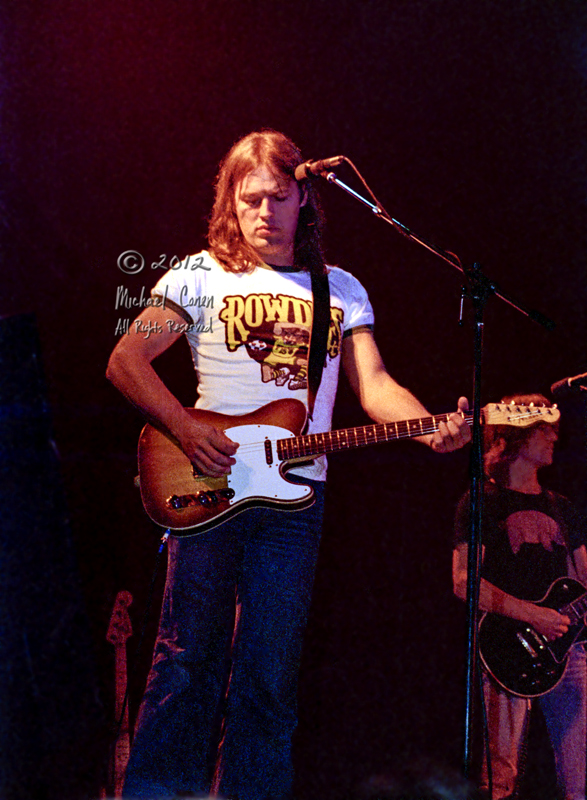





















Today, I will offer a great deal of “extra reading” to offset the fact that only a very few of my photographs of the band, came out to my satisfaction, for a few reasons: a densely packed audience meant a number of heads and shoulders to shoot around; members of the band were blocked by equipment at other angles; and one roll of film had “trouble” at the photo finishing outfit that I used at the time.
Now, back to a night which I had looked forward to, for a great deal of time… I could not see Pink Floyd on their previous visit to Louisville, on the tour promoting “Dark Side of the Moon“, as it was a school night [and, as noted elsewhere on my blog, that was not allowed by my parents, virtually until I finished high school……]. My best friend, Gary, however, managed to make that show, and regaled our circle about the terrific sound system they used, as well as the song selection which featured several tracks from their previous records, which were stellar, in their selection and performance [“Echoes” being one of my long-time favorites]: https://www.setlist.fm/setlist/pink-floyd/1973/louisville-convention-center-louisville-ky-7bd702e8.html.
My particular circle of friends and I had already been listening to their recordings since about 1969, between the releases of “Ummagumma” and the soundtrack to “More“, as finding the original releases of the first two albums was not so easy to do at the time, since they were on the Tower label, and distribution, pre-Harvest/Capitol Records, was not so great in our region of the States. By 1969–70, the band were becoming regularly played on FM “Underground” programs, which were far more relaxed about playing lengthier tracks – and not singles – by all sorts of bands [akin to the U.K.’s “pirate radio” phenomenon].
A bit of reading on the evolution of these changes on the FM spectrum in the U.S., are found at the following links:
Rock & Radio in the U.S., by Ben Fong-Torres – https://www.britannica.com/topic/United-States-1371176
Understanding Media & Culture: Evolution of Radio Broadcasting – https://open.lib.umn.edu/mediaandculture/chapter/7-2-evolution-of-radio-broadcasting/
A local newspaper article goes into some detail about some of the changes brought on by the emergence of “underground radio“, and how FM Radio, in the early-to-mid-Seventies rolled – for a time:
While the above station, WLRS–FM – soon to become known as “The Walrus“ – was early in the race to play album tracks as opposed to hit singles that were all over the AM Radio airwaves, and went on to become a major force in the regional market, my own tastes were far more impacted by the music selection broadcast by WSAC–FM. Their particular “progressive” programming hours were very limited – reportedly being instigated by the son of the owner of the station, who persuaded his father to free up a block of 6 hours each evening from the dual programming normally broadcast from the AM Radio broadcasting department, in an attempt to reach a different audience. While their signal was not powerful, coming out of the Fort Knox area, it was just enough to come through clearly in the communities where my friends and I were living, on the outskirts of the Louisville Metropolitan area. “The Walrus” focused on groups which basically had more of a track record of success playing in “name” halls, recording for well-established labels, and were already garnering type in the emerging alternative press, nationwide and abroad. WSAC would often play lesser-known performers, who often had only released one or two LP’s; had already disbanded and subsequent groups created from their ashes; individual member’s going on to release solo recordings; or, even more crucially, had not had their recordings released Stateside. It was there, that I first heard bands & artists as disparate as Premiata Forneria Marconi, McDonald & Giles, Gong, King Crimson, Soft Machine, Matching Mole, Hatfield and the North, Henry Cow, Frank Zappa and The Mothers of Invention, Weather Report, Return to Forever, Kevin Coyne, Nick Drake, Fairport Convention, Horslips, Gentle Giant, Genesis, Kevin Ayers, Robert Wyatt, Curved Air, Roxy Music….... and the list goes on and on. While their playlists, as it were, focused on Rock music and its tangents, they did not routinely play a great deal of Blues, Jazz or Classical – those genres would reveal their mysteries to me, later, via other friends’ and acquaintance’s record collections. It was also on WSAC, that my earliest introductions to Pink Floyd were heard. They played a great deal of the entire catalogue by the band, pre-“Dark Side of the Moon“, as well as the Syd Barrett solo recordings, which I also eagerly sought out, and was so happy to purchase when the Harvest imprint released the “two-for-the-price-of-one” of both LP‘s in the U.S... This mattered a great deal for those of us getting our spending money from mowing lawns or delivering newspapers, since the import copies were often the price of 3 domestic releases, or more, depending on the label!
During the late 60‘s and early 70‘s, the choices of stations to listen to, which played music that appealed to me and my friends, and those who were perhaps up to 10 years older, were quite limited. From our respective bedrooms, at home, we could tune in to the FM stations, such as LRS & WSAC, in the evenings. But, while out-and-about in automobiles, most of the time the listening was confined to AM Radio, such as WAKY and their singles – or, if we were lucky, someone had the money to install an 8-Track player or an even more expensive cassette deck, so complete albums could be listened to, while out on the roads, heading to the record shops, concerts, or just needing time away from the parents…
But, again, for me, WSAC was my top choice, until I left for university, and life became quite different – why, even for one year, I had a show of my own on the university’s carrier current station!
All of this extra reading material has been added, as background to my musical interests, which went from just listening, to wanting to attempt to document what I was seeing, live-in-performance. 1977 was the year that I briefly could afford to buy my first camera equipment, and then attempt to do just that – document, as best I could, the live performances I was attending. By the time Pink Floyd rolled through town, I had owned the camera for roughly seven weeks, and had shot a handful of shows, mostly in larger venues, like Freedom Hall, or Louisville Gardens [club shows were soon to become more available, once I reached the legal drinking age of 21, but that was still some time away ]. At each of these performances, I was subject to wherever I could manage to position myself, to take photos from within the general audience – and with very mixed results. Especially for these early attempts at large shows, I would be mostly disappointed with the results; obtaining perhaps 4 or 5 decent shots out of an entire roll, and one – maybe two – of those images would be worthy of a satisfying feeling. The images from this show would end up being “below average” in my estimation, mostly because it was nearly impossible to get close enough to avoid heads and shoulders making their presence known, in the exposures…. And, then, there was the “episode” involving the shop which processed my rolls of film: 3 rolls were handed in after the show, but only 2 rolls of prints came back, with a brief apology that “something went wrong with that roll, so here’s a roll of film to replace yours with”. Needless to say, I was quite perplexed as to how this could have happened, since this particular place had quite the business coming through, and, I was under the impression it had a good reputation – that is, until a couple of years later, during a conversation with another acquaintance, who had also shot photographs at some concerts and had his film processed at the same shop. He went on to inform me that he had experienced the same scenario, and had a feeling that the daughter of the owner had cherry-picked what she wanted, and arranged the “roll of film for your trouble”, and a wan “sorry” [she was close to our respective ages, and likely into similar musical tastes, and simply thought it was easy enough to take what she wanted, and leave the messy details up to whoever had to deal with the customers, later….]. I was quite unhappy about this, because I distinctly remember firing off a few more frames of the inflatables that hovered overhead, like the one I took of “the big shot”, in addition to more of the band members, proper….. This would teach me to be far more careful with where I had my color processing done, in the future, while I would go on to learn how to process my “pushed” black and white film, at a later stage in my endeavors.
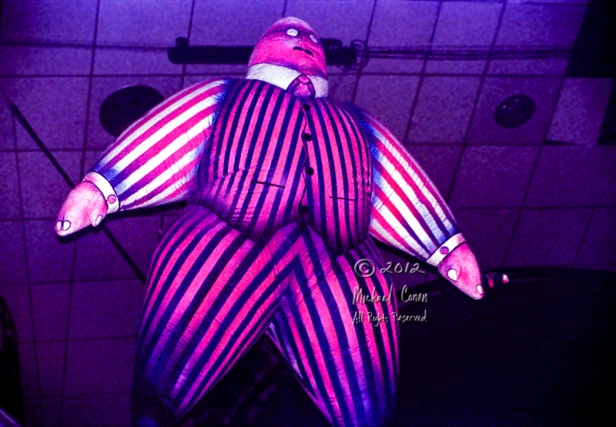
The only image of the airborne “characters” that came back from the film processing shop… The other roll that “something went wrong with” had 24 exposures that went missing, and has left me with a nagging suspicion about what really happened to them, ever since.
Getting back to the music on that evening: it was definitely an impressive “show”. The sound system was employed to great effect, as most concerts held there, did not really impress me, sound-wise. Often the concert’s sound would seem to bounce around, and echo too much at times, especially the farther back you would stand or sit. Pink Floyd‘s system was set up in a way that was hard to detect just where the PA speakers were located, but you could most definitely hear the recorded audio snippets of dialogue and animal sounds, coming from very distinct corners of the venue, while the band’s instruments were mixed very clearly. In my experience, there were only four performances where the sound at Freedom Hall exceeded the usual “tin box” sound, as I refer to it: Pink Floyd, on this occasion; Led Zeppelin, who appeared there in April of ‘77; ZZ Top, who also performed there in ‘77; and the Grateful Dead, who came with their “Wall of Sound” system, in ‘74. Zeppelin and ZZ Top were loud, but clear, while Pink Floyd and the Grateful Dead were quite crystalline, and not nearly as loud, with their sound systems.
One more tangent regarding Pink Floyd‘s music, before sharing a few of my photographs: just before my freshman year at university, “Wish You Were Here” came out. At this point in time, hearing the band’s music on FM Radio was no longer unusual. Certain tracks were now played multiple times on the radio each day; and one personal association/memory of this concerns one of my art classes at university: each morning during this life drawing class, the instructor would leave the local FM rock station on, while the students would commence work on their respective easels. Without fail, at each of these class meetings, the song “Welcome to the Machine” would come over the airwaves. Needless to say, after hearing this song a few dozen times in the span of 12 weeks of lessons, did not enamor me with that particular track [not being a fan of repetition in most matters, and especially as concerns “repeat plays” of music]. I was much more fond of “Have a Cigar” with Roy Harper on lead vocals, as well as the title song of the album, and the suite of songs centered on Syd Barrett, “Shine On You Crazy Diamond“. Roy Harper‘s work was also featured on WSAC, years earlier, and I would end up owning several of his albums, over the years, as I enjoyed the fact that he slipped so easily between his solo acoustic works, and those numbers that would be recorded with the aid of several notable U.K. musicians, including Gilmour, Jimmy Page and John Paul Jones, amongst others, and the quality of his songs remained consistently strong.
While I enjoyed “Animals” well enough, I found the next release more satisfying, overall, with “The Wall“. Of course, with the release of this album, and the subsequent film, their popularity reached a pinnacle, and it was at this point that my musical interests had undergone significant changes, and I found myself listening to less and less of Pink Floyd, as the years went by. I would still enjoy many collaborations that the individual members would take part in: Gilmour‘s involvement with bringing Kate Bush to the attention of the music world, and his work with others, like Pete Townshend. I still enjoy listening to the album that Nick Mason produced, on behalf of Carla Bley and her collaborators, “Fictitious Sports“. The late Richard Wright‘s first solo record, as well as Gilmour‘s, were both stronger, I felt, than some of their work, on those later Pink Floyd albums. In any event, I still routinely play albums from their early catalogue, especially the soundtrack to “La Vallee“, aka “Obscured By Clouds“, as well as a few live recordings that appeared over the years, from various BBC appearances on the radio, and a few other shows, that I once owned on vinyl…
*
This was a major moment to see on USTV, when it was first aired; it was such a thrill at the time to do so, and is very nice to go back and enjoy this performance from 1970, after all of these years:
https://www.youtube.com/playlist?list=PLsMuekXTxe9ybyhxiVrCtlv18FluQdmd7
Okay, if you have made it this far, it is time to spotlight the few images that I believe “work”. Some involved a bit of work, to make presentable, but a couple came out quite alright, if not “tops”…..
The above image is an alternate “take” on this negative. It was very difficult to capture a good frame of Mr. Waters, as I could not manage an easy angle to shoot from, or close enough to get enough lighting to produce a better one, than this.
These images, above, all demonstrate those pesky heads in the way of the shots, but, if you prefer, you can think of them as “clouds”…..
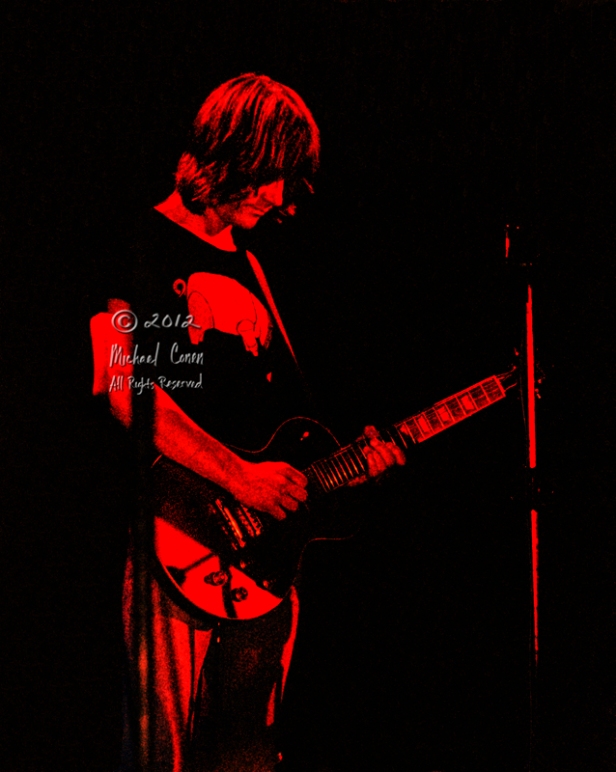
A very decent, if dark, image of Snowy White, a long-time auxiliary member of a number of Pink Floyd tours
Also partially blocked, but this frame of David Gilmour and Snowy White turned out quite alright.
Another take on a “cloudy” frame of Roger Waters, which almost “works”…
*
And the last image to share is one of the rare occasions when I took a snapshot of the audience. This was after the show, as I was leaving, and I came across a few acquaintances from my former high school. It would appear there are equal parts: happiness, bewilderment and recognition… and perhaps that “lingering feeling”.
**
Fortunately, as the number of shows I could get my camera into increased, and my opportunities to practice this passion grew, the results would slowly improve – in my estimation. The following links are to the shows by artists that are also mentioned in this post, above, that I also photographed:
“Where Were You?” – ZZ Top at Freedom Hall, Louisville KY [May 19th, 1977]
*
“Where Were You?” – Frank Zappa at Louisville Gardens, Louisville KY [11-10-77]
*
For photos I later took of The Who, please see here:
“Where Were You?” – The Who, Live at Rupp Arena [Lexington, Kentucky – July 11, 1980]
*
For photos of Richard Thompson and Simon Nicol, originally from Fairport Convention, on tour in 1982, promoting “Shoot Out the Lights“, please see here:
*
A link to a German site, which was kind enough to share a link to my post above, called “Pulse & Spirit: Pink Floyd Fanbasis”:
https://www.pulse-and-spirit.com/
**
As always, comments, including constructive criticism, are welcome here.
NOTE: A FEW WORDS ABOUT THE WATERMARKS ON MY WORK
While many of you who arrive here, to look at these photographs may get turned off to my use of watermarks [thinking they ruin the image], let the curmudgeon in me explain why I choose to do this.
No one paid for my camera equipment but me. No one paid for the film I used to take these photographs. On occasion, when I free-lanced for a free monthly newsletter, and they published a photo of mine, the payment for each photograph barely paid for the fuel to get my vehicle to the show [when I *did* have a vehicle], and the film I used on that night.
Not too many of my photos were published, at the time, because the artists I chose to capture images of, were not hugely popular then. Hence, the old dictum, “Supply and Demand”; I had the supply, but the demand [pre-Internet], was not there. You can argue the relative merits of the quality of my work, and that is precisely what a blog offers: a venue for discussion.
Back to the watermarks: no one is subsidizing my time to scan and then clean up the images I am presenting here. Start to finish, each negative will take approximately an hour-and-a-half to reach “proof” quality – which is what you will see here. This is my labor of love, and until there is some measurable return on my efforts, what you see is what you get.
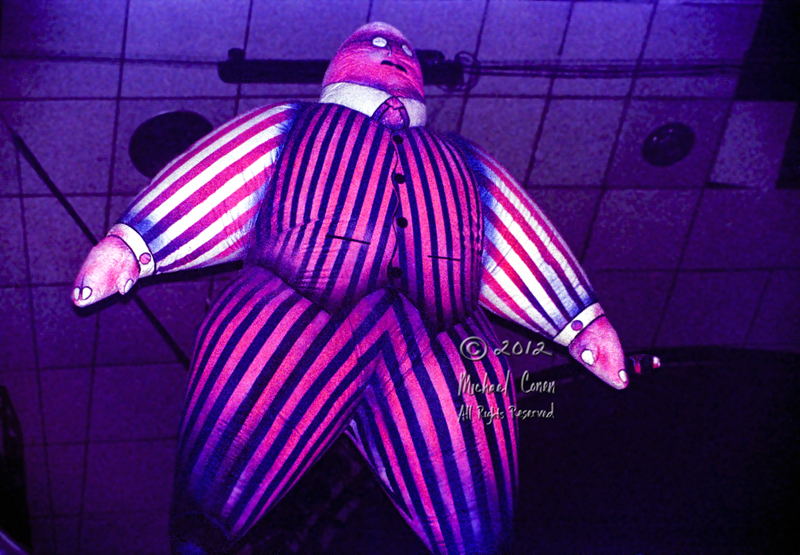








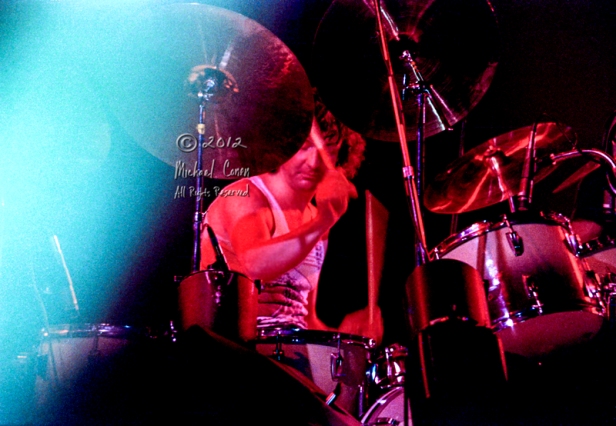
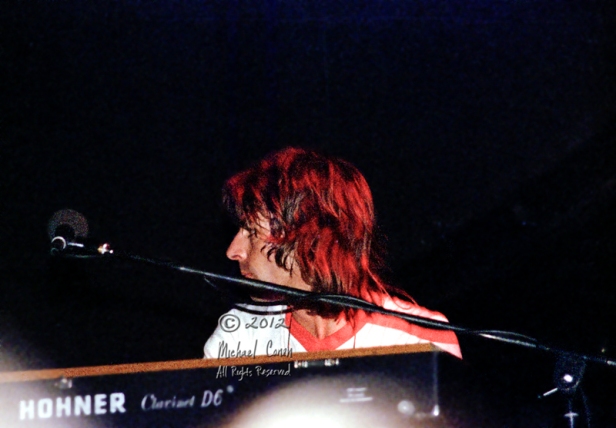

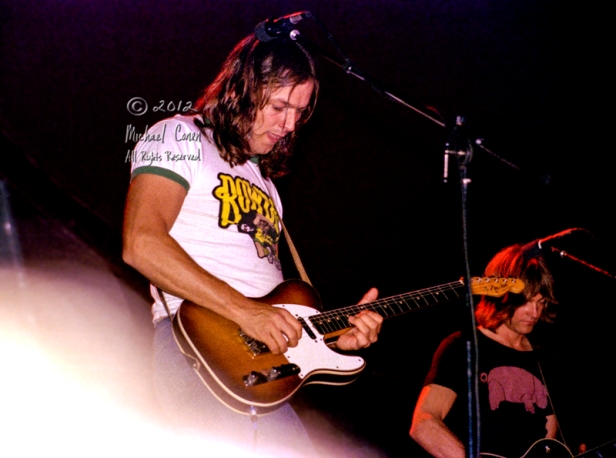
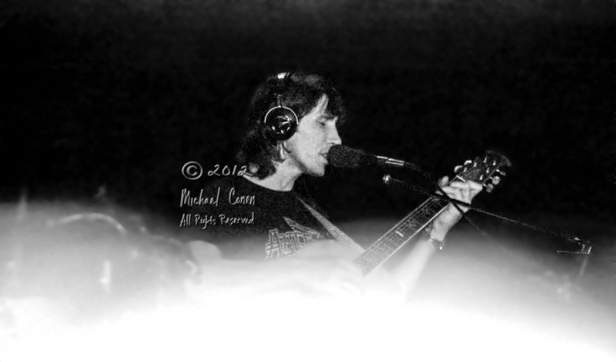
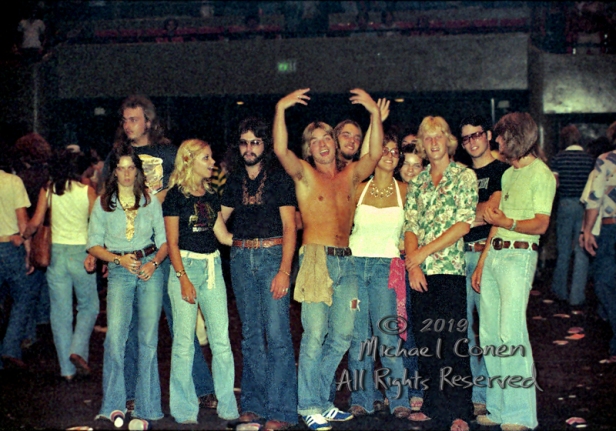
We had WKQQ in Lexington by 1974, and for their testing and the first year or so on the air they played nothing but whole sides of albums – it was SO great! After they got a few advertisers they would play one or two and hour, but then it was right back to the album sides! Terry Miner who is still in TV in Louisville was the first DJ I remember, but there was a woman, too. I used to go to the studio and help sort albums and just being a nuisance! I never attended a concert in Louisville until the Rush Moving Pictures tour because I was just more comfortable with the Lexington crowd and had heard some stories I didn’t want to be involved with! GREAT pictures as always! Peace!
LikeLiked by 1 person
Those days were great, weren’t they?!! The bane of the current listening & viewing experience: commercials, with a song in-between….
Very cool that you were able to enter the station/studios. The name Terry Miner rings a bell – will have to search that and see if there is a connection lapsing in my memory cells/synapses, or not.
Yes, you were better off, in some respects, staying in Lexington for those big shows. I neglected to mention the firecrackers that were tossed during the performance, which got Mr. Waters to comment at one point, and threaten to stop the show…. it was far worse at the Cincy stop, from what I recall [never enjoyed Riverfront Coliseum events].
Thanks for the compliment on the pix! It will be a bit before the next round pop up 😉 Peace to you, and stay safe!!
PS: Checked on the DJ, and discovered it is Terry Meiners, and I am sure I must have heard him when he was on air for Radio WQMF, although I cannot remember anything distinct about that. No mention of the female on air in those Lexington days, but I will do a bit more research on that, as I am curious 😉
PPS: Perhaps she might be one of the many, amongst these alumni of the station?
href=”https://www.topsinlex.com/Photos/12444/WKQQ-FM+Alumni+Rock+n+Roll+Reunion+” rel=”noopener” target=”_blank”>WKQQ Alumni gathering
LikeLiked by 1 person
Shannon sounds familiar, but I believe she used an on-air name which was different. Lots of DJs did that and still do. I’m certain that at one time or another I’ve heard all those people on the “Big Ol’ Funky Q”! I also listened to WQMF out of Louisville in the early 80s when I lived in northwest Kentucky. One thing for sure, we had a LOT of choices in radio back then! Not so much anymore, for sure. I feel lucky to live in southern Kentucky now where we have WDNS, a station that is still locally owned and takes requests! Also they have a web app so you can listen to them there, too. On Mondays the have The Lowdown Hoedown with Greg Martin (of Kentucky Headhunters fame), and he has special guests in the studio most Mondays. He’s had Warren Haynes on a lot and regularly gets people you’d never expect in-studio or on the phone. Check them out and call them up to request something – they WILL play it! Take care brother – and Peace!
John in Glasgow
P.S. Don’t miss Tommy Starr during the 3-7 PM slot, he plays a LOT of requests and you’ll hear songs you haven’t heard in a long time!
LikeLike
Hello John! Sorry about the late reply, but for some reason, this time your comment was directed to the spam queue, where I just discovered it!!!
Yes, it is probably safe to assume that Shannon used an air-name, as you say….. We were definitely lucky with the radio stations, for a time there, but it is true that there are still quite a number of fairly independent FM stations around the country – mainly at universities, or on the coasts, where there are a lot more licenses for stations, to begin with.
I hope the New Year is treating you well, and all is good for you – thanks a lot for dropping by again, and leaving more thoughts and remembrances. I will be adding more photos, from the 80’s again, in the near future 😉 Take care! Michael
LikeLike